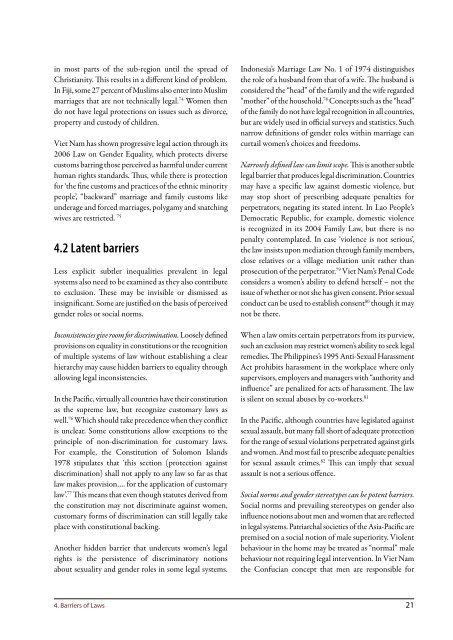Enforcing Rights and Correcting Wrongs - Asia-Pacific Regional ...
Enforcing Rights and Correcting Wrongs - Asia-Pacific Regional ...
Enforcing Rights and Correcting Wrongs - Asia-Pacific Regional ...
Create successful ePaper yourself
Turn your PDF publications into a flip-book with our unique Google optimized e-Paper software.
in most parts of the sub-region until the spread of<br />
Christianity. This results in a different kind of problem.<br />
In Fiji, some 27 percent of Muslims also enter into Muslim<br />
marriages that are not technically legal. 74 Women then<br />
do not have legal protections on issues such as divorce,<br />
property <strong>and</strong> custody of children.<br />
Viet Nam has shown progressive legal action through its<br />
2006 Law on Gender Equality, which protects diverse<br />
customs barring those perceived as harmful under current<br />
human rights st<strong>and</strong>ards. Thus, while there is protection<br />
for ‘the fine customs <strong>and</strong> practices of the ethnic minority<br />
people’, “backward” marriage <strong>and</strong> family customs like<br />
underage <strong>and</strong> forced marriages, polygamy <strong>and</strong> snatching<br />
wives are restricted. 75<br />
4.2 Latent barriers<br />
Less explicit subtler inequalities prevalent in legal<br />
systems also need to be examined as they also contribute<br />
to exclusion. These may be invisible or dismissed as<br />
insignificant. Some are justified on the basis of perceived<br />
gender roles or social norms.<br />
Inconsistencies give room for discrimination. Looselydefined<br />
provisions on equality in constitutions or the recognition<br />
of multiple systems of law without establishing a clear<br />
hierarchy may cause hidden barriers to equality through<br />
allowing legal inconsistencies.<br />
In the <strong>Pacific</strong>, virtually all countries have their constitution<br />
as the supreme law, but recognize customary laws as<br />
well. 76 Which should take precedence when they conflict<br />
is unclear. Some constitutions allow exceptions to the<br />
principle of non-discrimination for customary laws.<br />
For example, the Constitution of Solomon Isl<strong>and</strong>s<br />
1978 stipulates that ‘this section (protection against<br />
discrimination) shall not apply to any law so far as that<br />
law makes provision…. for the application of customary<br />
law’. 77 This means that even though statutes derived from<br />
the constitution may not discriminate against women,<br />
customary forms of discrimination can still legally take<br />
place with constitutional backing.<br />
Another hidden barrier that undercuts women’s legal<br />
rights is the persistence of discriminatory notions<br />
about sexuality <strong>and</strong> gender roles in some legal systems.<br />
4. Barriers of Laws<br />
Indonesia’s Marriage Law No. 1 of 1974 distinguishes<br />
the role of a husb<strong>and</strong> from that of a wife. The husb<strong>and</strong> is<br />
considered the “head” of the family <strong>and</strong> the wife regarded<br />
“mother” of the household. 78 Concepts such as the “head”<br />
of the family do not have legal recognition in all countries,<br />
but are widely used in official surveys <strong>and</strong> statistics. Such<br />
narrow definitions of gender roles within marriage can<br />
curtail women’s choices <strong>and</strong> freedoms.<br />
Narrowly defined law can limit scope. This is another subtle<br />
legal barrier that produces legal discrimination. Countries<br />
may have a specific law against domestic violence, but<br />
may stop short of prescribing adequate penalties for<br />
perpetrators, negating its stated intent. In Lao People’s<br />
Democratic Republic, for example, domestic violence<br />
is recognized in its 2004 Family Law, but there is no<br />
penalty contemplated. In case ‘violence is not serious’,<br />
the law insists upon mediation through family members,<br />
close relatives or a village mediation unit rather than<br />
prosecution of the perpetrator. 79 Viet Nam’s Penal Code<br />
considers a women’s ability to defend herself – not the<br />
issue of whether or not she has given consent. Prior sexual<br />
conduct can be used to establish consent 80 though it may<br />
not be there.<br />
When a law omits certain perpetrators from its purview,<br />
such an exclusion may restrict women’s ability to seek legal<br />
remedies. The Philippines’s 1995 Anti-Sexual Harassment<br />
Act prohibits harassment in the workplace where only<br />
supervisors, employers <strong>and</strong> managers with “authority <strong>and</strong><br />
influence” are penalized for acts of harassment. The law<br />
is silent on sexual abuses by co-workers. 81<br />
In the <strong>Pacific</strong>, although countries have legislated against<br />
sexual assault, but many fall short of adequate protection<br />
for the range of sexual violations perpetrated against girls<br />
<strong>and</strong> women. And most fail to prescribe adequate penalties<br />
for sexual assault crimes. 82 This can imply that sexual<br />
assault is not a serious offence.<br />
Social norms <strong>and</strong> gender stereotypes can be potent barriers.<br />
Social norms <strong>and</strong> prevailing stereotypes on gender also<br />
influence notions about men <strong>and</strong> women that are reflected<br />
in legal systems. Patriarchal societies of the <strong>Asia</strong>-<strong>Pacific</strong> are<br />
premised on a social notion of male superiority. Violent<br />
behaviour in the home may be treated as “normal” male<br />
behaviour not requiring legal intervention. In Viet Nam<br />
the Confucian concept that men are responsible for<br />
21


